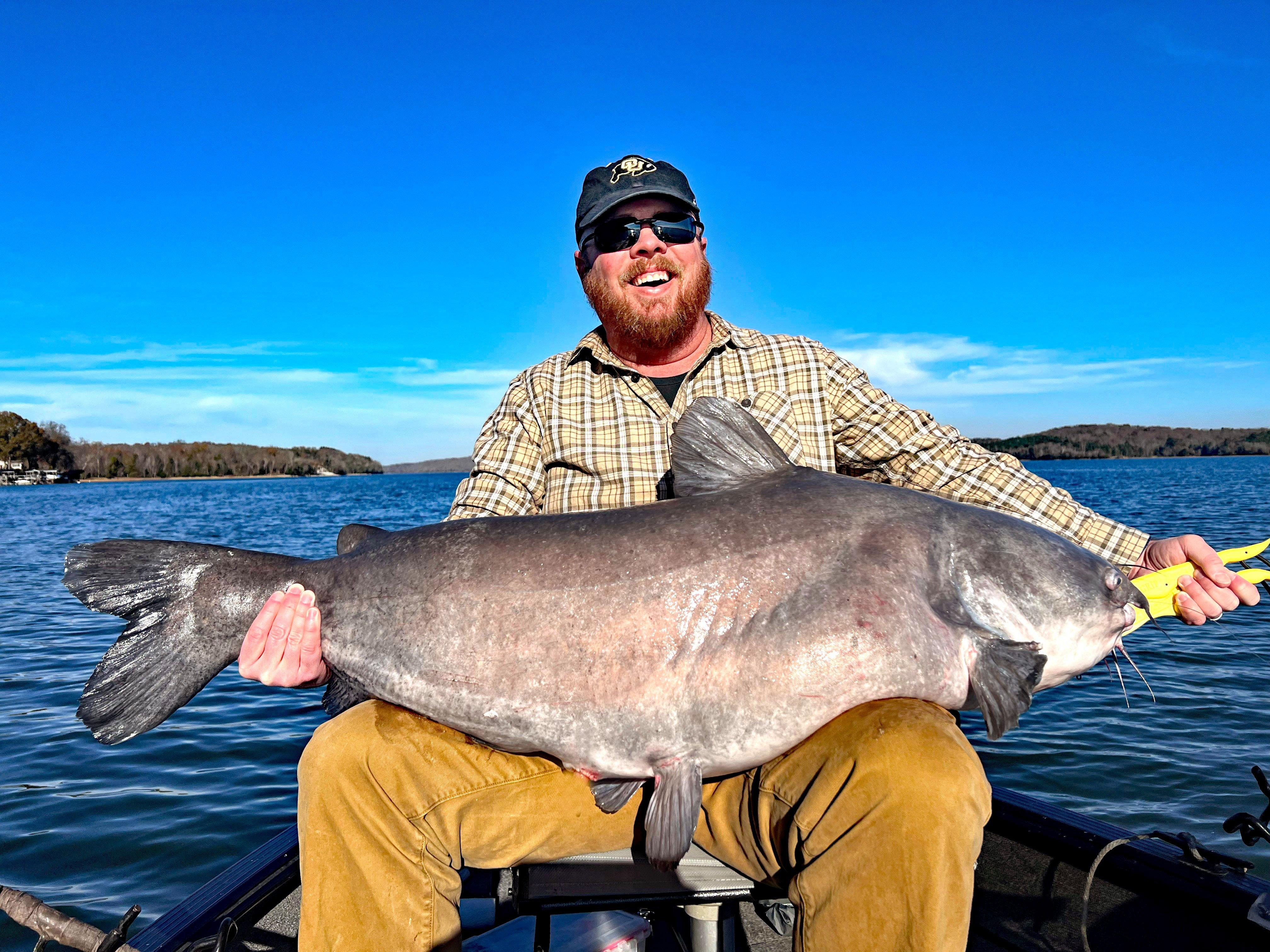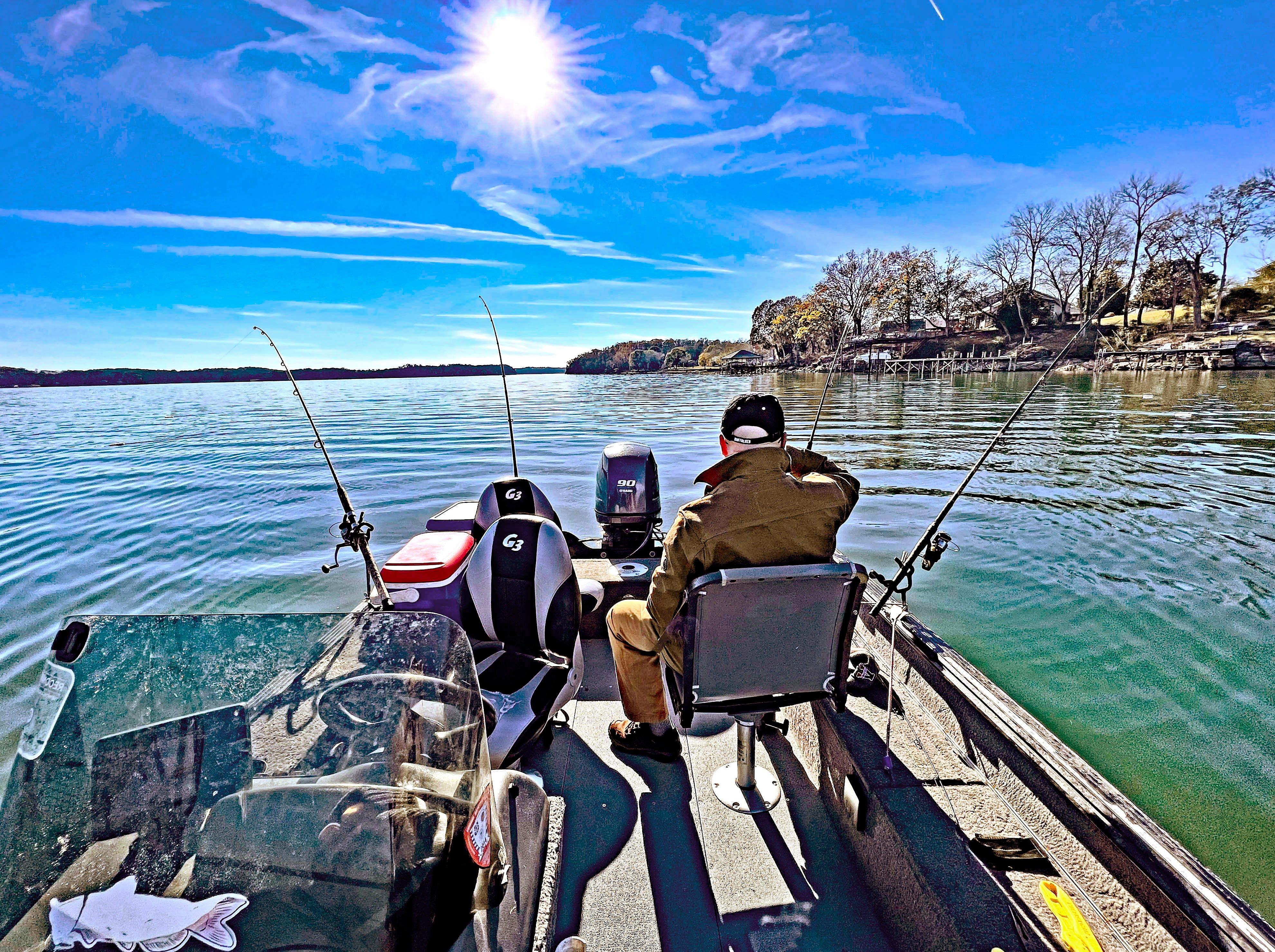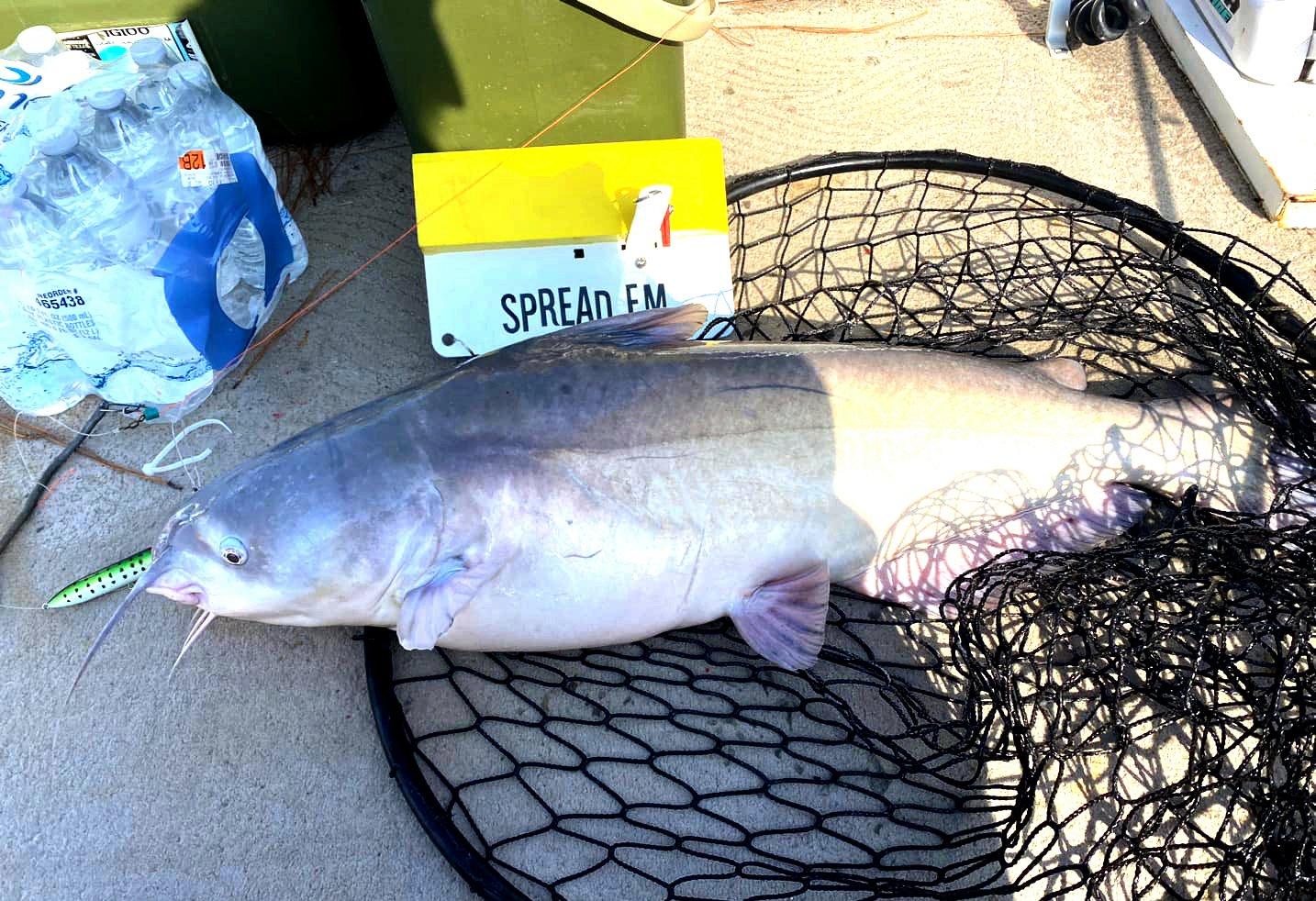When catfish are scattered, nothing is better for covering water than pulling boards

When smaller catfish hit beneath a planer board, it’s sometimes hard to tell if it’s a fish or a snag. But when this behemoth took the bait, the planer board shot across the water like a rocket, and Ross Roberson knew he was hooked up with something special. The beast weighed 72 pounds. Image courtesy of Capt. Richard Simms
I’ve been a hardcore catfish angler for more than 30 years and a professional catfish guide for nearly 18 years. When most people think about catfishing, they envision folks sitting on shore or in a boat, casting out two or three rods, usually baited with chicken liver, and then sitting and waiting — and waiting, and waiting some more. Many equate their vision of catfishing with watching paint dry.
It doesn’t have to be like that. I detest just casting lines out and playing the waiting game. Sure, it’s part of my guiding repertoire, but it’s the least favorite of my techniques. I prefer all my fishing, even catfishing, to be more proactive.
Don’t be deceived. Catfishing is never going to be as varied and proactive as bass fishing, but it’s a far cry from what many believe it to be. Especially if you factor in planer boards.
That’s right. More often nowadays, catfishermen are adopting the ways of salmon, walleye, and even blue-water anglers. They are trolling for catfish, covering significant expanses of water. In other words, they are going to the catfish rather than waiting for catfish to come to them.
“I call it search and destroy,” said Capt. Mark Nawrocki, with DeucesWildFishing.com. “In my catfishing, I’m probably dragging planer boards 85% or 90% of the time.”
First, a rudimentary lesson for those who might not know. A planer board is just that; a board that floats on the surface of the water. By attaching your fishing line to it on the side, using a special quick-release clip, coupled with forward motion of the boat, the board acts as a wing and planes out, pulling the line(s) away from the boat’s path.
A well-rigged boat can easily have out eight lines — four on each side of the boat — covering an expanse of water 200 feet wide. Coupled with the boat’s forward motion, a catfisherman’s baits are presented across a huge area and are far more likely to come across a hungry catfish, compared to two or three baits sitting in one spot on the bottom.
Besides covering huge areas of water, it’s incredibly exciting to see a planer board get ripped across the surface when a big catfish latches on. Remember the movie Jaws, when the shark is dragging the huge yellow barrels across the water? That’s what a hard hit from a catfish on a planer board often looks like.
Granted, I was slow to come to planer board game. I bought planer boards and toyed with them through the years but never fully committed until this past year. I was inspired by one of my guide partners, Capt. Aaron Massey, who often uses planer boards in certain situations.
Massey had been on a tear, garnering some great catches on planer boards this past fall. I was inspired to get out and reintroduce myself to the technique the day before Thanksgiving 2022. I dragged son-in-law Ross Roberson along for my exploratory mission, designed primarily for me to refresh my memory about using planer boards.
Don’t Miss: PRO TIPS FOR KEEPING FISH ALIVE IN LIVEWELLS

Aaron Massey prefers Spread ‘Em planer boards because they let him use standard line-release clips, or he can use a Twistlock clip, which locks the line tight and can only be released when the angler reels the board to the boat. Standard 10-inch Spread ‘Em planer boards retail for $35.99 apiece. Image courtesy of Capt. Richard Simms
It had been a while since I had pulled boards, and I was trolling over virgin water, chosen because the depth-finder showed me a tabletop-smooth bottom, where I was unlikely to snag while climbing the learning curve.
Therefore, I was shocked when the distant starboard planer board suddenly got crushed, flying backward as if possessed by demons. The demon, however, was a healthy blue cat. Ross and I were on the board (pun intended) with the first catfish of the day.
The water temperature was 53 degrees. My Humminbird wasn’t marking many fish. I was on the main channel of the Tennessee River in Chickamauga Lake, fishing water about 30 feet deep, using Clearboard planer boards.
About 30 minutes after the first catfish, another planer board went flying, this time carried by a healthy 18-pound blue. I decided that regardless of what the bottom looked like or what the Humminbird displayed, Ross and I should continue. In time, we were rewarded by a third flying planer board.
I often use relatively light tackle compared to other trophy catfishermen. I think you get more bites and definitely get more fight. Fishing B’n’M catfish spinning rods, Ross was feeling every ounce of energy the fish had.
I knew it was a good fish but told Ross, “On this gear, at first it’s really hard to tell if you’re fighting a 20-pound fish or 50-pound fish.”
Ten minutes later, when Ross got the fish near the boat the first time, we were in awe at its size.
Then the beast screamed back for the bottom, peeling the 50-pound-test Power Pro braided line off the Okuma Avenger reel. The back-and-forth battle continued for another 10 or 15 minutes until we finally netted and dropped Ross’s personal-best catfish — 72 pounds — on the deck.
Ross looked at me, slightly out of breath, and said, “Yeah, this planer board thing works.”
Massey spends most of his catfishing time on the Tennessee River, sometimes on reservoirs and sometimes in tailwaters. Depending on recent rainfall and releases from TVA dams, and upon which section of river he’s in, he can often fish where there’s quite a bit of current. But sometimes, rainfall and minimum water releases brings about a lack of current, especially on the larger mainstream reservoirs. That’s when he pulls out the planer boards.
Don’t Miss: SALMON SHARK DISCOVERED ON SHORE OF IDAHO RIVER LIKELY A PRACTICAL JOKE

Planer boards let catfishermen cover a lot of water. Trolling at 0.5 mph with lines spread out 200 feet side-to-side means there’s a much better chance of finding active fish rather than sitting in one spot waiting on fish to come to you. Image courtesy of Capt. Richard Simms
“Yeah, I usually base the boards on the current or the lack of current,” Massey said. “With good current, I typically anchor or vertical drift. But if there’s not enough current to anchor or drift effectively, the next thing I’ll go to is pulling boards. It simply allows me to cover much more water and put the bait in front of more fish.
“If the current is flowing less than 1 mph, that’s when I’ll use the boards. But it won’t really work well if the current is running faster than that.”
Nawrocki fishes reservoirs, usually avoiding tailwater areas near the dams — hence his heavy dependence on planers boards.
“In areas without a lot of current, catfish don't hold or congregate in particular areas,” he said. “So, I often run boards along the river channel ledges. The lines on one side of the boat might be up in 20 feet of water, while the lines on the other side of the boats are in 40 or 50 feet of water. Then I just cover lots of water looking for active fish.”
Nawrocki said his normal trolling speed pulling boards is 0.5 mph. But he says a good rule of thumb is to troll based on the water temperature. For example, if water temperatures are cold — down in the 40s — he won’t troll faster than 0.4 mph. But if water temperatures are higher, say up in the 60s, he might troll up to 0.6 mph.
The standard rig is to use a three-way swivel with a snagless sinker set to drag along the bottom, with the bait drifting above the sinker.
Nawrocki said, “If I’m in water less than 20 feet deep, I use a 1.75-ounce sinker. If it’s 20 to 40 feet deep, I’ll use 2.75 ounces. Deeper than 40 feet, I’ll go up to a 4-ounce sinker. He prefers sinkers from Drifting Stix.
Massey’s rigging technique is similar.
“I bait up and cast it behind the boat as far as I can throw it,” he said. “I’ll release line, making sure that it is dragging or bumping bottom based on the depth and my trolling speed. Then I’ll just hook my board to the line and let them start spreading out. I’ll usually have about three times the water depth of line behind my boards.”
Don’t Miss: 10 SURPRISING TIMES WHEN WEARING CROCS IS APPROPRIATE

Capt. Richard Simms, the author, uses 10.5-inch Clearboards from Double X Tackle. They retail for $70.99 per pair. Image courtesy of Ross Roberson
Massey typically sets three lines on each side of the boat. He prefers using 10-inch (Large) Spread ’Em Planer Boards.
Spread ‘Em offers two styles of line clips. Grip clips release the line when a fish hits so the angler has a direct line to the fish immediately, without the full drag of the planer board.
However, Spread ‘Em also offers a Twistlock clip, which locks the line tight and can only be released when the angler reels the board to the boat, where your partner can remove the board.
Massey prefers the Twistlock clips.
“If you have a bait snag on the bottom, you can either pull it free or break it off, and the board stays attached to your line,” he said. “With the Grip style, the line comes unclipped, and the board will slide off your line if it breaks. Then you have to pull all your lines in and turn around to go back and retrieve it.”
I set my lines somewhat differently. I run line through the free swivel of my Clearboards and drop my three-way rigs straight down on 50-pound-test braided line. When my 3-ounce standard sinkers hit bottom, I release about 30 feet of additional line and then clip it to the board. Then I adjust my trolling speed to keep sinkers and baits bumping bottom. In very light current (maybe 0.2 mph), an upstream trolling speed of about 0.5 or 0.6 mph in 30 feet of water keeps my baits on the bottom or in the strike zone.
“Pulling boards is not a great thing to do over a rocky, snaggy bottom,” Massey said. “You just get hung up too much. But the best thing about it, you often get some really aggressive strikes. Pulling bait under the boards just seems to initiate great reaction strikes. It’s a blast when you see one of the boards just take off.”
Massey and Nawrocki agree that there is no perfect way to rig or drag in every scenario. They say everyone needs to practice and adapt whatever techniques work best for the water you’re fishing.
The most important thing is to just do it. If you’ve never used the technique, it’s one more excellent weapon everyone should add to their catfishing arsenal.
From Chattanooga, Tenn., Capt. Richard Simms is the owner of Scenic City Fishing Charters, Inc. He is also the editor of CrappieNOW.com and serves on the board of the Southeastern Outdoor Press Association. He began his outdoor career as a Tennessee game warden, later choosing journalism (and guiding) as his profession. Check out his book, "An Outdoor State of Mind." You can contact him at [email protected].










